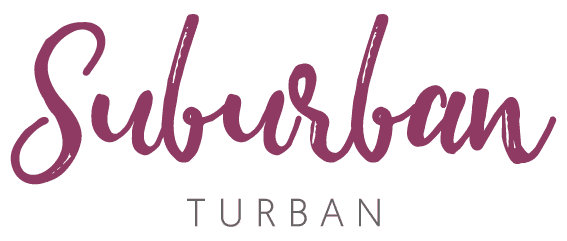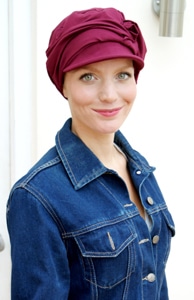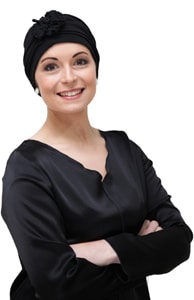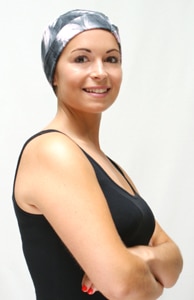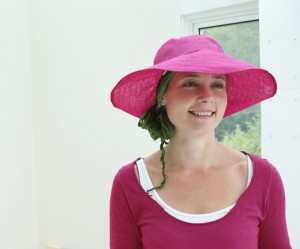Menu
How can I look fashionable in hair loss headwear?
What styles suit your lifestyle? Cute beanies and caps for casual everyday; or classic turbans for smart ‘back to work’ wear and always a soft sleep hat for catching hair and keeping cosy
Like it or not, anyone wearing a hat today is making a fashion statement, simply because not many people wear them these days on a daily basis, apart from the ubiquitous baseball cap. Many women feel uncomfortable wearing a hat, with the most common reason seemingly that hats “just don’t suit them and they don’t look right in them”. Perhaps it is just because we don’t wear them very often and we just don’t know what suits us. So how do women get to a point where they feel comfortable in hats, let alone confident enough to create their own distinctive hat wearing style? And what happens if wearing a hat suddenly becomes a central issue in your life?
For women experiencing hair loss either because of chemotherapy side effects, Alopecia areata or hair thinning, this is exactly what happens and it becomes an additional challenge they face. To cope with this impact of a prolonged period of hair loss, it becomes essential that they feel able to ‘manage’ their new image and wearing hats or other types of headwear is part of this strategy.
Understanding your face shape is the first step. The shape of your face is a key factor in selecting the best headwear for you. A hat creates a sense of presence and is a way to reflect your personal style. And the way it works with hairstyles is the way it works with hats. Not all hat styles will flatter you, but rest assured there is a style out there that will suit you. The tricky bit is finding it!
Face Shape Table
|
Square Face
|
Whatever style you choose, wear your hat at a slight slant or tilt; this will give a more flattering asymmetrical look to your face.
|
|
Round Face
|
Do not select hat styles that are narrower than the width of your face i.e. Fez or flower pot shapes. Wider shapes with brims will suit you better. It is worth noting that you can make a hat ‘look’ bigger by adding trim detail or selecting the design in a vibrant colour, (even though the basic shape hasn’t changed at all). This is why it is key to try a shape on in a variety of colours; colour affects size. With a round face your hats should only be worn at a slight angle.
|
|
Narrow/Long Face
|
Avoid tall hats, instead try hats with brims (they don’t have to be big) just enough to add width around the head.
|
|
Heart-shaped Face
|
If you have wide cheekbones or a heart shaped face, you’ll look good in any style, even those head-hugging styles that can be so hard to wear. Wear them straight across the forehead or hairline.
|
|
Wide Face
|
Hats worn off the face work well, tilted towards the back of the head, (think Jackie Onassis and you’ve captured the style). Hat styles that are naturally worn high on the forehead will always suit you.
|
|
Big Nose
|
If your nose isn’t your favourite feature, wear your hats so that they sit forward on the head (buy styles that give deeper coverage at the nape of the neck), preferably with a brim or peak to draw attention away from it.
|
N.B Remember these are only guidelines, not hard and fast rules.
There are always ways of altering a hat to suit. Trims in particular can change the shape/width of a hat drastically. Colour and fabric texture (print or stripe) also play an important role in ‘disguising’ the overall shape of the hat. Trailing round department stores trying on shapes is one option, although if you really don’t know what suits you, this can be exhaustive and more than a little disheartening. Another alternative is to ask your friends and family to root out every hat they’ve ever bought. Then in front of a full-length mirror try them all on, taking a little time to assess each one properly.
The reason for the full-length mirror is that it gives a sense of proportion from hem to waistline and from waistline to neckline. It also allows you to see the hat width or lack of width on your upper body. If you can’t find a full-length mirror, find the biggest mirror you can and preferably a hand held mirror as well, so that you can see the back of your head comfortably. (Look into the hand held mirror with your back to the larger mirror and turn your head and the mirror until you can see the back of your head.)
Now you’ve got the best chance of assessing how you look from all sides, so alter how you’re wearing the hats whilst they are on your head. Try them from side to side, on a slant or with a front to back tilt. If a friend is on hand, ask them to look in the mirror with you, rather than at you, before they comment. Because the mirror flattens ‘the picture’ and you see yourself in two dimensions, it is easier for us to take in the ‘full effect’, rather than looking directly at the person. If you do that you will end up looking where you always do, at the person’s face and not studying the upper body.
Don’t give up…
If you are unsuccessful in finding the perfect style from your hoard, take a different view. Try not to view the hat as a single component, but think about it in two parts – the crown and the brim. Compile a picture of all the ‘best bits’ of the hat, for example, taking the crown from one with the brim of another may ‘make’ your perfect hat. Or perhaps a side trim that works better than a material drape all the way round the hat. Once you have a firm idea of what works, start your search in retail outlets and on the web. Don’t get waylaid or distracted; you now know what suits you, because you have done your groundwork. It may take a little longer but once you’ve found ‘your style’, you can duplicate it, triplicate it and buy it in as many colours to suit your wardrobe. Now you’re buying with confidence. Does it look more stylish and fashionable than a simple head-scarf? Without a shadow of a doubt – it will!
Hats that flatter
The key message from the table above is that brims and peaks are easier to wear, and more flattering to more face shapes. When brims are mentioned most women think Ascot ‘super saucers’, but this needn’t be the case. There are styles out there that incorporate small soft brims that mean you don’t have to worry about knocking them when you’re out in the supermarket or walking around.
If you look better in hats that have detail on one side because it balances your face shape, then don’t be afraid to experiment. Look at what accessories you could comfortably wear up there – sparkly hair clips, felt flower brooches, soft crochet flower pins, leather flowers, small diamante brooches, large decorative coconut shell or wooden buttons sewn onto the hat.
You may be reading this and thinking “I could never do that”. Well maybe not in the past, but as a woman experiencing significant hair loss you now find yourself with a whole new image to ‘manage’ and this requires a new approach. Not a theatrical ‘make-over’, or even close to it, but simply an open-minded approach to review your style potential and experiment with jewellery, accessories and make-up. It may take a little time and a little practise but the benefits to your self-esteem and self-assurance will be immeasurable.
Facebook
Twitter
LinkedIn
WhatsApp
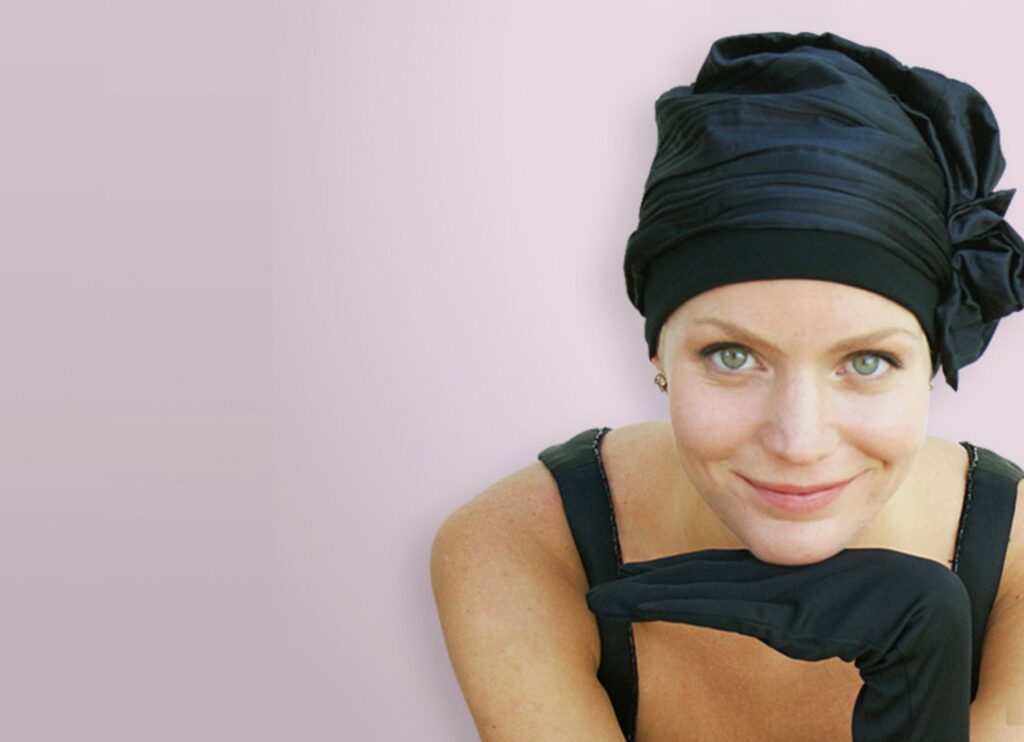
ABOUT THIS BLOG
News and advice for women experiencing hair loss.
